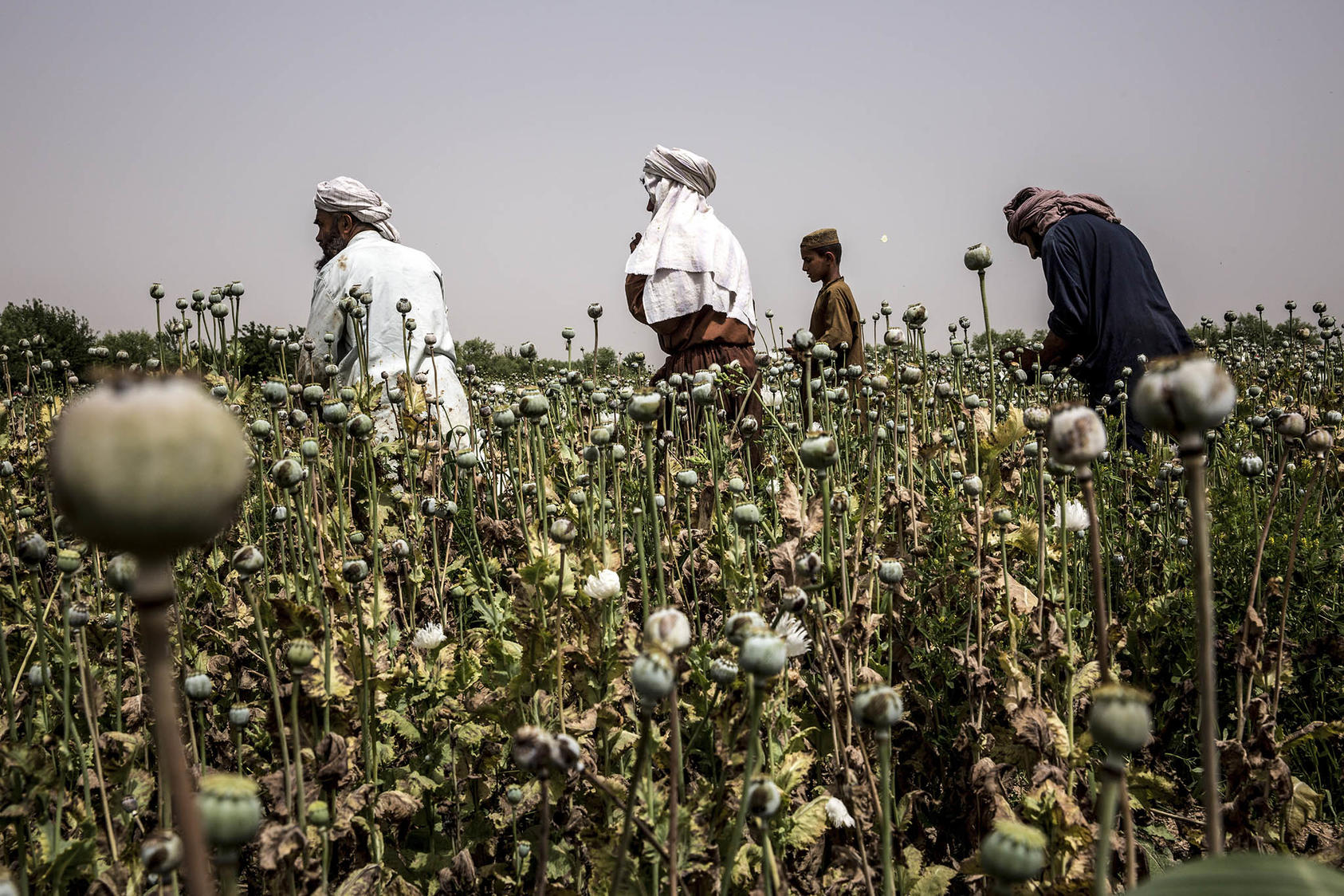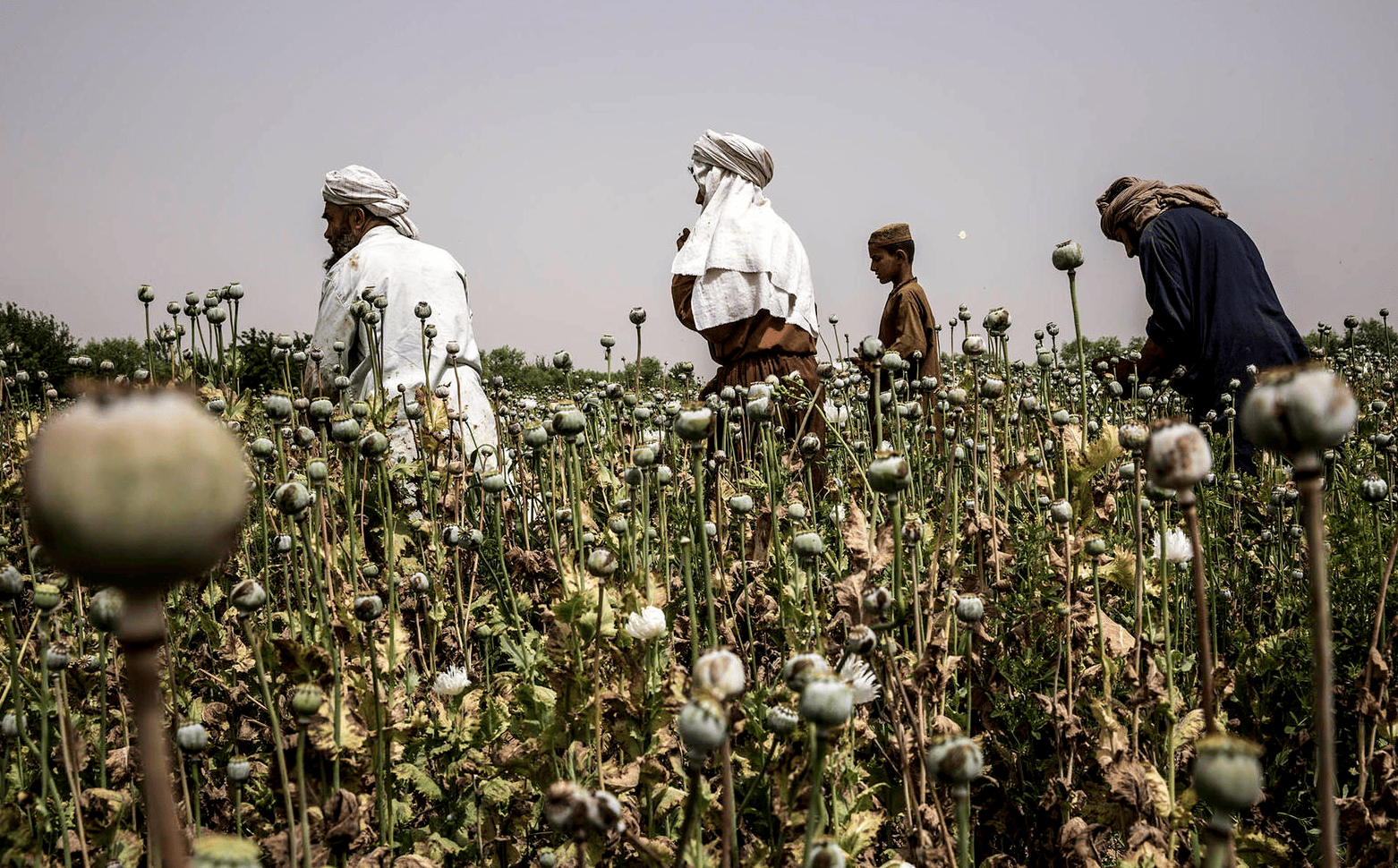The ban is not a counter-narcotics victory and will have negative economic and humanitarian consequences, potentially leading to a refugee crisis.

The Taliban’s Highly Successful Opium Ban
Satellite imagery analyzed by Alcis and associated research by David Mansfield, an independent researcher who has conducted extensive fieldwork and analysis on Afghanistan’s opium sector and rural economy for more than a quarter-century, show that the Taliban opium ban, announced in April 2022, has been remarkably successful in sharply reducing opium poppy cultivation. In Helmand, by far Afghanistan’s largest opium-producing province, the area of poppy cultivation was cut from over 129,000 hectares (ha) in 2022 to only 740 ha as of April 2023. The reduction in Nangarhar, another long-standing opium producing province, is also impressive — only 865 ha this year compared to over 7,000 ha in 2022.
This is the pattern more broadly in south and southwest Afghanistan. Reductions in other provinces such as Badakhshan will be more limited, but these areas produced much less opium in the first place. Though the full picture is not yet clear, Afghanistan may approach the 90 percent reduction in cultivation achieved during the Taliban’s previous opium ban in 2000-2001. This is an undeniable achievement, particularly given the much larger size of the opium economy this time around (an estimated 233,000 ha in 2022 versus some 82,000 ha in 2000).
How was the ban implemented so successfully? As Mansfield argues, the Taliban took a relatively sophisticated, staged approach that evolved and intensified over time. The announcement of the ban was not accompanied by eradication of 2022’s bumper crop of poppy fields that were about to be harvested, which would have met fierce resistance. This gave rise to uninformed speculation that the ban was not serious. The Taliban did engage in eradication of the much smaller spring and summer crops subsequently planted in 2022, intended to deter others.
There were also major efforts during 2022 to crack down on ephedra, the main ingredient for Afghanistan’s thriving methamphetamine industry. These actions sent strong signals to the rural population in advance of the fall 2022 planting season, which, along with outreach and threats, effectively deterred planting of opium poppy in the south and southwest of the country. As a result, the bulk of the reduction in poppy cultivation reflected people not planting in the first place, and this was complemented by eradication of some remaining poppy fields soon after planting.
Unlike the Taliban’s previous opium ban, the current ban encompasses trade and processing of opiates, not just poppy cultivation. But just as the standing 2022 winter crop was exempted from eradication, it appears that trade in opium produced in 2022 and earlier has been allowed to continue. With the sharp decline in opium poppy cultivation for this year’s harvest, the bulk of ongoing trade must be in the ample supplies of “older” opium (UNODC estimated that Afghan opium production was 6,800 metric tons in 2021 and 6,200 metric tons in 2022). It remains to be seen whether this is a temporary dispensation or will be more permanent. In 2000-2001, trade in opiates was never hindered.
Immediate Economic Damage
The economic shock from the opium ban is enormous: Not including adverse effects on downstream processing, trade, transport and exports, Afghanistan’s farm-level rural economy has lost more than $1 billion per year worth of economic activity as calculated by Mansfield, including as much as hundreds of millions of dollars that had accrued to poorer wage laborers and sharecroppers. These people and their families, already at the margin of subsistence and lacking other job opportunities in Afghanistan’s very weak economy, will be at even greater risk of hunger, malnutrition and associated health problems.
This economic shock comes on top of a significant reduction of humanitarian aid in store for this year — likely at least a $1 billion reduction compared to the $3 billion of humanitarian aid delivered in 2022. Thus Afghanistan’s mostly poor, deprived population will be doubly squeezed.
Moreover, replacing poppy with wheat (as has been happening during the current opium ban) is economically unviable for Afghanistan’s rural sector as a whole and especially for households owning limited or no land. Most Afghans don’t achieve food security by growing their own food. Rather, people make ends meet by growing cash crops or producing other agricultural products (e.g., livestock and dairy), which can be sold to provide resources to purchase food needs, or by working other jobs. Wheat is a low-value crop and a poor substitute for opium, though it does serve as a temporary recourse for people who may expect to return to opium poppy later, in particular for landowners whose fields are ample enough to serve their own family’s food needs. Fruits and other tree crops would be more viable substitutes for opium poppy over the long run but require significant time and investments.
Another, related outcome is that more people will try to leave Afghanistan, going to nearby countries and then onward to Turkey and Europe. As Mansfield documents, the cost of people smuggling is low compared to the potential rewards of being employed in and sending remittances from Europe. Moreover, other alternatives for the poor that were available before August 2021 (like finding work in cities, other rural on-farm and non-farm activities, or the Afghan National Army) are now limited to nonexistent.
Delayed and Longer-term Impacts
Additional damage from the opium ban will materialize with a delay, over the coming months and years.
An important buffer for better-off rural households is the inventories of opium they have built up from the 2022 bumper crop. Landowning households able to hold on to their opium inventories have benefited from capital gains as the price rose, and can sell off some of them to offset the loss of this year’s crop, while growing wheat and other crops to feed their families. (It should be noted that the Taliban as a movement and now as a governing regime do not hold sizable inventories of opium.)
This buffer will erode over time. Suffering will increase among middling farm households as they exhaust what inventories they have of opium and are forced into more harmful coping mechanisms, as poorer households have already done in response to broader economic privation: selling livestock and other remaining assets, eschewing medical care and medicines, eating less and lower-quality food, sending family members out of the country, or even marrying off daughters prematurely.
The impact of the opium ban on drug supplies and prices in other countries, and ultimately in Europe, will not be immediate. After the 2000 Taliban ban, it took about 18 months to two years for the impacts to play out in Europe, as Mansfield notes, in the form of effective price increases through adulteration of the purity of heroin on markets, which exacerbated risks to problem drug users from overdoses. Such impacts probably would become significant this time around if the opium ban is effectively implemented for a second year.
What Happens Next?
The big question now is whether or not the poppy ban will be maintained for a second year.
Historically, there have been examples of successful opium bans in Afghanistan, both nationally (2000-2001) and regionally (Nangarhar province for a number of years, significant reductions in Helmand on two occasions). But maintaining these bans has invariably proved difficult. It is unclear what the Taliban would have done during the late 2001 planting season, after the 2000 ban weakened them politically in key rural areas and arguably contributed at least in part to their surprisingly rapid defeat by international forces after 9/11. There were already signs of increasing resistance against the ban, which suggest that it could not have been fully maintained even if the Taliban had remained in power. And the provincial-level bans during the Islamic Republic period became increasingly hard to sustain over time as privation and resistance against them grew.
So, implementation of the ban for a second year can be expected to face increasing resistance. As more influential middle-sized and larger landowners in the south and southwest deplete their opium inventories they are unlikely to be as accepting as they were in the first year and could even lobby against continuation of the ban. As a core Taliban constituency, their voices will be heard, though to what effect remains to be seen. And in the east and northeast, where landholdings are small and resistance already significant, it may well snowball if the ban is enforced for a second year.
The political blowback within the Taliban from the ban, limited and manageable so far, thus may intensify if the ban continues to be seriously implemented into 2024. In addition to influential landowners, Taliban figures associated with the drug industry may increasingly weigh in or actively try to subvert the ban, at least locally.
However, the serious, sustained effort that went into implementing the opium ban in its first year, and the political and personal capital Emir Haibatullah Akhundzada has invested in this effort, suggest that it will continue and there won’t be an outright reversal. And the economic shock and human suffering will continue and worsen as long is the ban is implemented.
International Response?
There will probably be a counter narcotics-driven, knee-jerk response that the effectively implemented Taliban opium ban is a good thing. However, history amply demonstrates that banning opium in Afghanistan by itself is not sustainable, nor does it address the drug problem in Europe and elsewhere. And it won’t stop rampant drug use within Afghanistan. Supply-side measures will not work if not backed up with sensible development interventions to help make them sustainable. This is especially true given the weak Afghan economy and lack of ample non-drug income earning opportunities. And simply put, these measures will not reduce drug consumption unless accompanied by effective demand reduction measures.
The Taliban opium ban may provide a well-grounded justification for more humanitarian assistance. As with that aid as a whole, however, this would just be a band-aid to provide temporary relief unless and until the opium ban is rescinded or undercut. Moreover, any bump to humanitarian aid that may materialize will at best maintain it closer to the existing level, not result in an increase from last year.
Some forms of basic needs rural development aid could be helpful — agricultural support, small-scale rural infrastructure, income generation, small water projects, investments in agro-processing and marketing, and the like. It would make sense to orient any basic needs assistance that becomes available for Afghanistan in these directions, while recognizing that the modest amounts of money involved will at best have a marginal impact. Custom-made, standalone “alternative livelihoods” projects should be avoided, especially if designed, overseen or implemented by counter-narcotics agencies, which lack development expertise. It is broader rural development that will over time make a difference, as part of a healthy, growing economy that generates licit jobs and livelihoods opportunities.
And finally, the international response must acknowledge not only the overall damage that the opium ban is causing for the Afghan economy, but also the likely upsurge in outmigration that will result. Trying to block people flows at the Afghan border will work only imperfectly, and to the extent it is successful will worsen privation and hunger within the country.
Overall, while understanding the extraordinary success of the Taliban’s opium ban and what it tells us about the Taliban’s strength and effectiveness as a governing regime, the international response must be clear-eyed about the very real costs the ban imposes both on Afghanistan and the world, on top of the other very serious economic and social problems the country faces.
From usip.org
Disclaimer: We at Prepare for Change (PFC) bring you information that is not offered by the mainstream news, and therefore may seem controversial. The opinions, views, statements, and/or information we present are not necessarily promoted, endorsed, espoused, or agreed to by Prepare for Change, its leadership Council, members, those who work with PFC, or those who read its content. However, they are hopefully provocative. Please use discernment! Use logical thinking, your own intuition and your own connection with Source, Spirit and Natural Laws to help you determine what is true and what is not. By sharing information and seeding dialogue, it is our goal to raise consciousness and awareness of higher truths to free us from enslavement of the matrix in this material realm.
 EN
EN FR
FR



























Me again,last time,promise!According to Ishmael Perez and the yanihian script (also known as the winds of truth,God (he/she),created eleven other universe before this one!We are the culmination of all of them.Including the infamous black ray(evil) thirteenth universe.All as experiments!One was all male,another all female!Yes,the could reproduce,except instead of sex,they did so by a holy kiss,as did the earliest root races!Others were based on science,technollogy,machinery,holiness,you get the idea!Just a few more things to consider.
I almost forgot!I think a lot of the confusion also comes from the fact that we normally cutout the spiritual when dealing with problems in the physical,mental and emotional!You cannot get the right answer if you already cutoff access to it!Also,I do not think that most people understand that we existed as full hermaphadites during the third? root race!Until we were forced to change genetically in order to make us easier to handle as slaves!That was part of the experiment then!Of course the genetic remnants almost certainly still exist somewhere in our gene pool!
Ok,this comment not about this article.Is it possible someone could write an article about this comment?We have a huge problem in trannies and sexual dexphoria (spelled wrong) Has anyone ever looked into a potential tranny's past lives?It could be as simple as them being the opposite sex in their last life!If this is so,then explaining that to them would do far more than any shrink!Explain that this life they are meant to learn their lessons as a man(woman)and changing that might cause them to miss those lessons and even require another(unnecessary lifetime to learn them again!That might go over better than demanding they stay as is simply because we say it is right!
Funny how history repeats itself if we didn't learn from the past. Remember Oliver North???